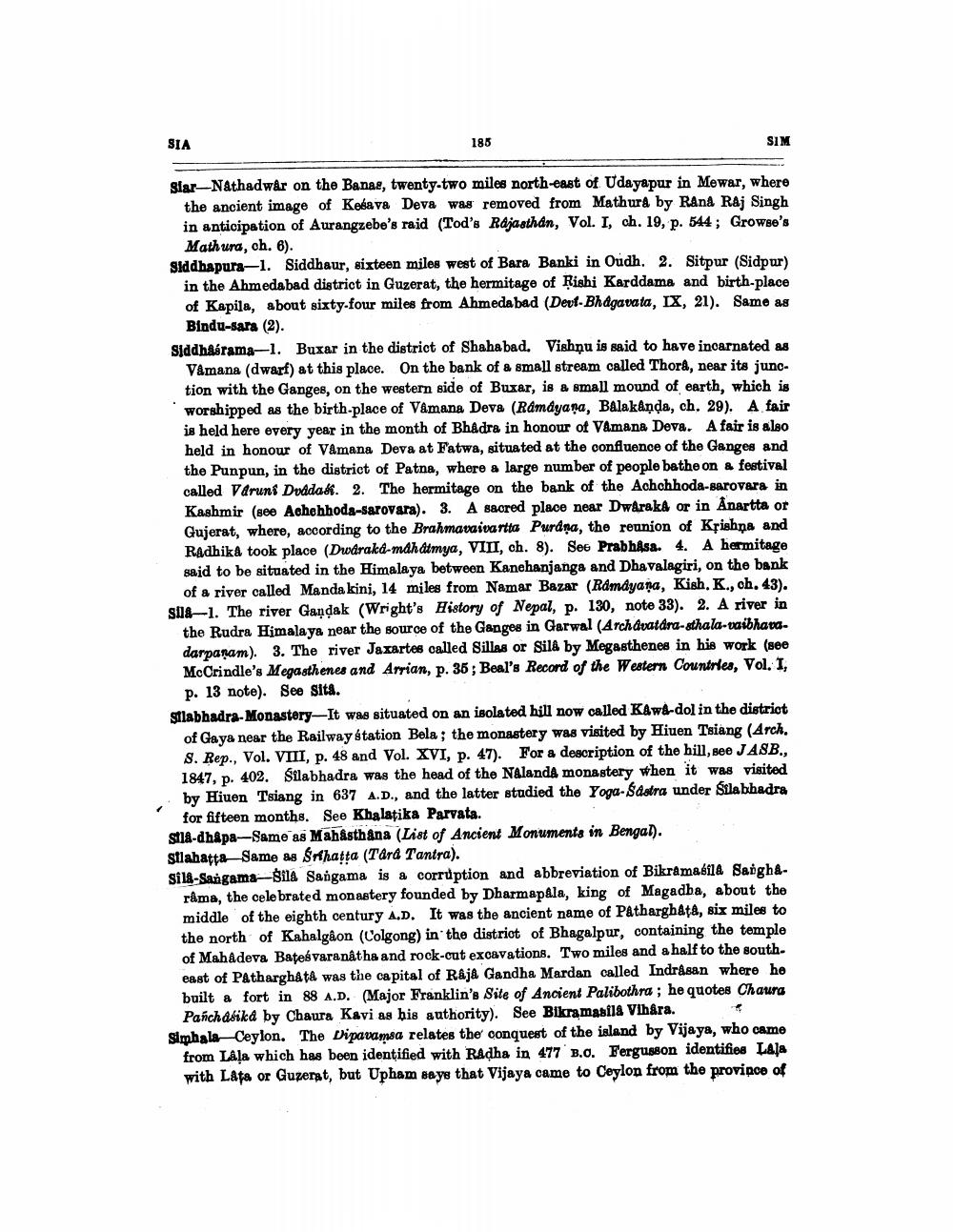________________
SIA
185
SIM
sfar-Nathadwar on the Banae, twenty-two miles north-east of Udayapur in Mewar, where
the ancient image of Kebava Deva was removed from Mathura by Rana Raj Singh in anticipation of Aurangzebe's raid (Tod's Rajasthan, Vol. I, ch. 19, p. 544; Growse's
Mathura, ch. 6). Siddhapura-1. Siddhaur, sixteen miles west of Bara Banki in Oudh. 2. Sitpur (Sidpur)
in the Ahmedabad district in Guzerat, the hermitage of Rishi Karddama and birth-place of Kapila, about sixty-four miles from Ahmedabad (Devl-Bhagavata, IX, 21). Same as
Bindu-sara (2) Siddhasrama-1. Buxar in the district of Shahabad. Vishnu is said to have incarnated as
Vamana (dwarf) at this place. On the bank of a small stream called Thord, near its junction with the Ganges, on the western side of Buxar, is a small mound of earth, which is worshipped as the birth place of Vamana Deva (Ramdyana, Balakanda, ch. 29). A fair is held here every year in the month of Bhadra in honour of Vamana Deva. A fair is also held in honour of Vamana Deva at Fatwa, situated at the confluence of the Ganges and the Punpun, in the district of Patna, where a large number of people bathe on a festival called Varuni Doddak. 2. The hermitage on the bank of the Achchhoda-Barovara in Kashmir (see Achchhoda-sarovara). 3. A sacred place near Dwaraka or in Anartta or Gujerat, where, according to the Brahmavaivartta Purdna, the reunion of Krishna and Radhika took place (Dwdraka-mahatmya, VIII, ch. 8). See Prabh&sa. 4. A hermitage said to be situated in the Himalaya between Kanehanjanga and Dhavalagiri, on the bank
of a river called Manda kini, 14 miles from Namar Bazar (Ramayana, Kish. K., ch. 43). 818-1. The river Gandak (Wright's History of Nepal, p. 130, note 33). 2. A river in
the Rudra Himalaya near the source of the Ganges in Garwal (Archduatdra-sthala-vaibhana. darpanam). 3. The river Jazartes called Sillas or Silê by Megasthenes in his work (see McCrindle's Megasthenes and Arrian, p. 35; Beal's Record of the Western Countries, Vol. I,
p. 13 note). See sita. stlabhadra-Monastery-It was situated on an isolated hill now called Kawa-dol in the district of Gaya near the Railway station Bela; the monastery was visited by Hiuen Tsiang (Arch. 8. Rep., Vol. VIII, p. 48 and Vol. XVI, p. 47). For a description of the bill, see JASB., 1847, p. 402. Silabhadra was the head of the NalandA monastery when it was visited by Hiuen Tsiang in 637 A.D., and the latter studied the Yoga-Sastra under Šilabhadra
for fifteen months. See Khalaţika Parvata. sha-dhapa--Same as Mahästhana (List of Ancient Monuments in Bengal). stlahattaSame as Srihatta (Tara Tantra). Silk-Sangama-Sila Sangama is & corruption and abbreviation of Bikramasila Sangh
råma, the celebrated monastery founded by Dharmapala, king of Magadba, about the middle of the eighth century AD. It was the ancient name of Patharghata, six miles to the north of Kahalgaon (Colgong) in the district of Bhagalpur, containing the temple of Mahadeva Batesvaranatha and rock-cut excavations. Two miles and a half to the south. east of Patharghata was the capital of Raja Gandha Mardan called Indrasan where he built a fort in 88 A.D. (Major Franklin's Site of Ancient Palibothra ; he quotes Chaura
Panchasikd by Chaura Kavi as his authority). See Bikramasila Vihara. Simhala Ceylon. The Diparamsa relates the conquest of the island by Vijaya, who came
from Lala which has been identified with Radha in 477 B.O. Fergusson identifies LALA with Lata or Guzerat, but Upham says that Vijaya came to Ceylon from the province of




